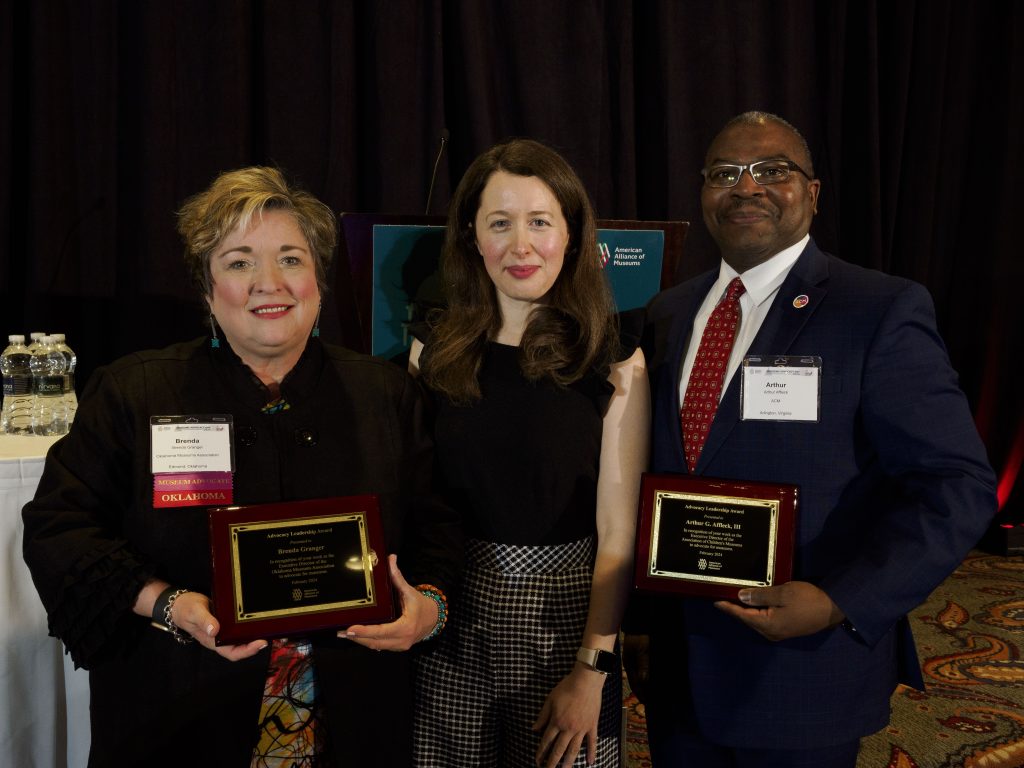
ACM is pleased to share that the association’s executive director, Arthur G. Affleck, III, has been honored by the American Alliance of Museums (AAM) with a 2024 Advocacy Leadership Award.
The award, which was presented during AAM’s Museums Advocacy Day on February 26, 2024, is presented annually to advocates who demonstrate exemplary leadership in their advocacy for the museum field.
“As Executive Director of ACM, Arthur brings a passion for education and equity as well as a proven record of accomplishment in the nonprofit sector,” says Brooke Leonard, Interim CEO/chief of staff at AAM, of the recognition. “Arthur’s commitment to elevating children’s museums and enriching the lives of children and families has led ACM to new levels of activity, visibility, and impact.”
Arthur joined ACM as Executive Director in January 2022, to lead the association which serves more than 470 members in 50 states and 11 countries. Under his vision and leadership, ACM has expanded programs, established new partnerships, and prioritized advocacy at all levels of government and across the museum field as critical for not only children’s museums, but for museums of all types. This work is guided by ACM’s new strategic plan, introduced in January 2023. The plan includes four aligned priorities which include elevating the children’s museum community, lifting up children and families, advancing the field through advocacy, policy, and research, and strengthening the organization. ACM’s participation in AAM’s annual Museums Advocacy Day, as well as the concentrated strategic initiatives, research, and professional development, reflect the importance of amplifying the field and championing issues that effect it.
Upon receiving the award, Arthur shared the recognition with the ACM Board of Directors, professional staff, and members of the field, and emphasized, “this award belongs not just to me, but to my colleagues at ACM and the countless individuals and organizations dedicated to advocating for museums and their essential role in our society so that we may all better support children and families.”
“This award belongs not just to me, but to my colleagues at ACM and the countless individuals and organizations dedicated to advocating for museums and their essential role in our society so that we may all better support children and families.”
Arthur Affleck, upon receiving the award, shared the recognition with the ACM Board of Directors, professional staff, and members of the field.
ACM, together with our partnering host museum, Madison Children’s Museum, will convene children’s museums professionals across the world at InterActivity 2024: Flourish!, May 15-17.
A highlight of every InterActivity, the opening plenary session highlights a keynote presentation that leverages expert knowledge in a related field to address the issues and opportunities confronting children’s museums. This year, the opening plenary will feature three small talks speakers framing lively short presentations around the conference theme, highlighting the ways museums, communities, and the children we serve can flourish in an ever-changing world.

Lynda Barry
Cartoonist and Professor of Interdisciplinary Creativity
Drawbridge: Making Comics with Kids
How old do you have to be to make a bad drawing? Most people give up on being able to draw at about the age of eight or nine when they realize they can’t draw a nose or hands in a representational way. There is another kind of drawing that can leap right over this problem of good and bad, which can allow us to experience a way of making pictures that set the conditions for discovery and insight and can be used by anyone of any age. What might it be? Can drawing with kids bring mutual benefit?
Creativity Sparks a Flourishing Spirit
Lynda Barry has worked as a painter, cartoonist, writer, illustrator, playwright, editor, commentator and teacher and found they are very much alike. The New York Times has described Barry as “among this country’s greatest conjoiners of words and images, known for plumbing all kinds of touchy subjects in cartoons, comic strips and novels, both graphic and illustrated.” She earned a degree from Evergreen State College during its early experimental period (1974-78), studying with painter and writing teacher
Marilyn Frasca. Frasca’s questions about the nature of images and the role they play in day-to-day living have guided Barry’s work ever since. In 1979 while pursuing a career as a painter, Barry began drawing a weekly comic strip incorporating stories considered to be incompatible with comics at the time. Stories, as Barry puts it, “that had a lot of trouble in them.” Widely credited with expanding the literary, thematic and emotional range of American comics, Barry’s seminal comic strip, Ernie Pook’s Comeek, ran in alternative newspapers across North America for thirty years

Richard J. Davidson, PhD
William James and Vilas Research Professor of Psychology and Psychiatry and Founder & Director of the Center for Healthy Minds, University of Wisconsin-Madison. Founder and Chief Visionary for Healthy Minds Innovations, Inc.
The Science of Wellbeing: Teaching and Training for Healthy Minds, Brains, and Bodies
Just like being physically in shape means regular exercise, supporting one’s emotional well-being begins with a training program – for the mind. In this talk, world renowned neuroscientist, Dr. Richard J. Davidson discusses the scientific concept of neuroplasticity and how research in the lab confirms that well-being is a skill that can be taught. By learning and practicing the skills associated with awareness, connection, insight, and purpose – anyone can have a healthier mind, despite their external circumstances. Based on four decades of contemplative neuroscientific research, Dr. Davidson outlines a path to well-being for anyone in this highly relevant talk.
Human Flourishing & Well-being
Davidson received his PhD from Harvard University in Psychology in 1976. Davidson’s research is broadly focused on the neural bases of emotion and emotional style and methods to promote human flourishing including meditation and related contemplative practices. He has published over 573 articles, numerous chapters and reviews and edited 14 books. He is the author (with Sharon Begley) of “The Emotional Life of Your Brain” published in 2012 and co-author with Daniel Goleman of “Altered Traits” published in 2017. He was named one of the 100 most influential people in the world by Time Magazine in 2006. He was elected to the National Academy of Medicine in 2017 and appointed to the Governing Board of UNESCO’s Mahatma Gandhi Institute of Education for Peace and Sustainable Development (MGIEP) in 2018. In 2014, Davidson founded the non-profit, Healthy Minds Innovations, which translates science into tools to cultivate and measure well-being.

Charles Hua
Founder and Executive Director of PowerLines, Senior Advisor at the U.S. Department of Energy Loan Programs Office, and Research Affiliate at Lawrence Berkeley National Laboratory
negative space
Discussing his climate journey—from first learning about climate change and the importance of taking initiative from his second teacher to launching a campaign for Madison Metropolitan School District to become the nation’s then-largest school district with a 100% renewable energy goal to now serving in the Biden-Harris Administration and advising on clean energy policy—Charles Hua will illustrate how the thoughtful mentorship and support he received along the way has shaped him into the person and leader he now aspires to be.
Environmental Flourishing
Charles Hua is the Founder and Executive Director of PowerLines, Senior Advisor at the U.S. Department of Energy Loan Programs Office, and Research Affiliate at Lawrence Berkeley National Laboratory. Previously, Charles advanced building electrification policy with Rewiring America. In college, Charles was appointed to serve on the Harvard Presidential Committee on Sustainability, where he helped develop and write Harvard’s sustainability plan and organized the inaugural Harvard Climate Summit. Charles has advised Fortune 500 companies and international NGOs on sustainability issues and serves on the Board of Directors for environmental nonprofits Slipstream, Energy News Network, and Clean Wisconsin. Born and raised in Madison, Wisconsin, Charles organized a campaign that successfully petitioned his school district to become the largest in the U.S. at the time with a 100% renewable energy commitment. For his work, Charles has been recognized by the White House as a 2018 U.S. Presidential Scholar, by the Aspen Institute as a Future Climate Leader, and as an Energy News Network 40 Under 40 honoree. Charles holds an A.B. in Statistics and Mathematics from Harvard College.
Barry, Davidson, and Hua will present on Thursday, May 16 at the Opening Plenary session at InterActivity 2024. For more details about the entire conference, view the preliminary program. Registration is now open.
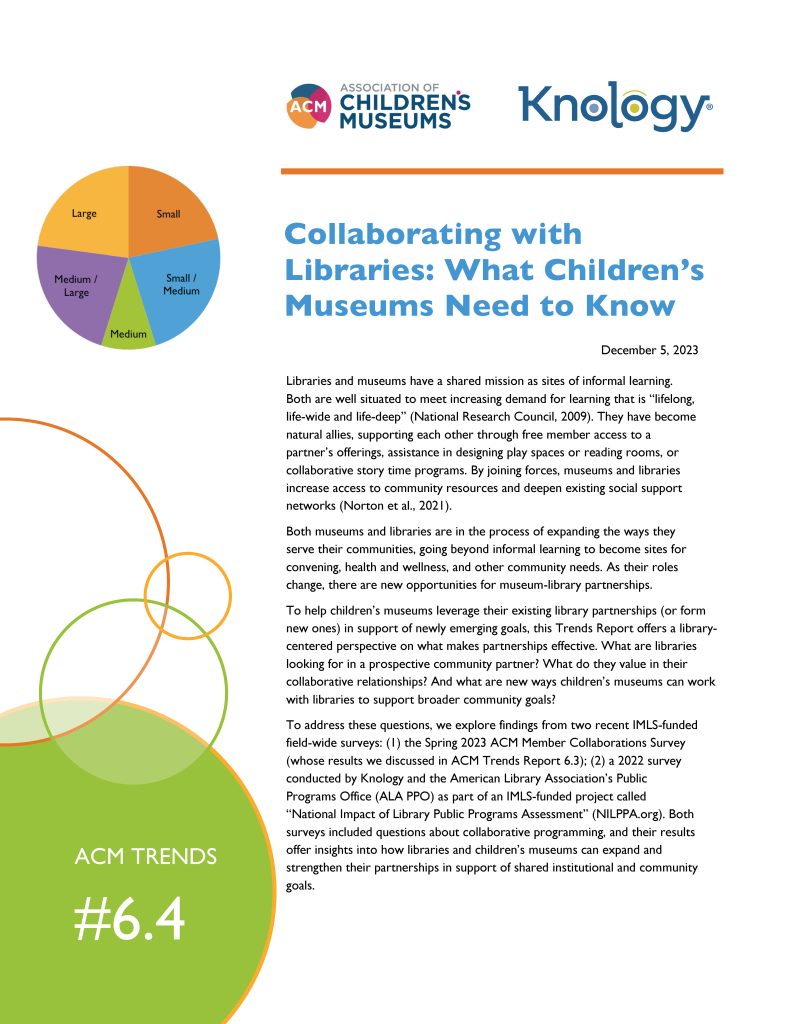
Data for this report comes from two surveys. That pertaining to children’s museums’ collaborations with libraries was collected through the Spring 2023 ACM Member Collaborations survey. The dataset contains information from 59 member institutions. Data on library collaborations with museums was collected through a NILPPA survey of US libraries conducted in 2022. This dataset contains information from 314 libraries. Research for both of these projects is supported by the Institute for Museum and Library Services (Grant #s: MG-251839-
OMS-22; MG-80-19-0042-19; LG-250153-OLS-21).
Libraries and museums have a shared mission as sites of informal learning.
Both museums and libraries are in the process of expanding the ways they serve their communities, going beyond informal learning to become sites for convening, health and wellness, and other community needs. As their roles change, there are new opportunities for museum-library partnerships. To help children’s museums leverage their existing library partnerships (or form new ones) in support of newly emerging goals, this Trends Report offers a library centered perspective on what makes partnerships effective. What are libraries looking for in a prospective community partner? What do they value in their collaborative relationships? And what are new ways children’s museums can work with libraries to support broader community goals?
The survey also offered insights into the goals children’s museums are pursuing through collaboration. Though varying considerably, museums’ collaborative goals are connected to three broadly shared aims: (1) healing; (2) learning; (3) community. In what follows, we discuss how these findings can help children’s museums understand, approach, and evaluate collaborative work. Our hope is that sharing this information will not only stimulate dialogue around collaboration and partnership, but also help children’s museum leaders plan new collaborative programs and begin the process of building relationships with new partners.
To address these questions, we explore findings from two recent IMLS-funded field-wide surveys: (1) the Spring 2023 ACM Member Collaborations Survey (whose results we discussed in ACM Trends Report 6.3); (2) a 2022 survey conducted by Knology and the American Library Association’s Public Programs Office (ALA PPO) as part of an IMLS-funded project called “National Impact of Library Public Programs Assessment” (NILPPA.org). Both surveys included questions about collaborative programming, and their results offer insights into how libraries and children’s museums can expand and strengthen their partnerships in support of shared institutional and community goals.
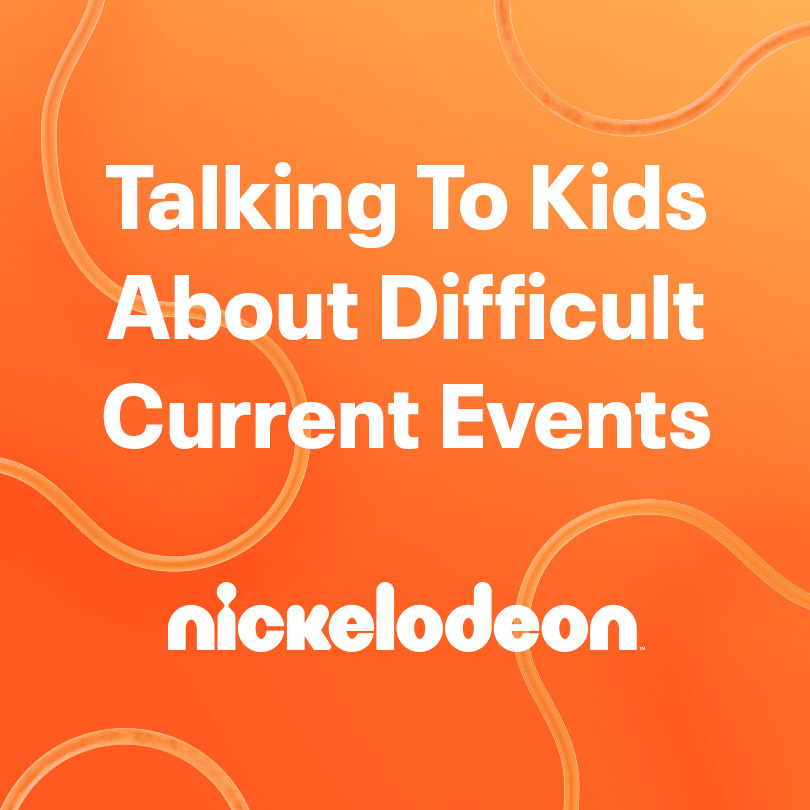

It can be tough to discuss difficult topics with kids, but having candid conversations can help your child understand and cope with disturbing current events. ACM partnering organization Nickelodeon put together Nickelodeon’s Guide to Talking to Kids About Difficult Current Events. This guide was created to help parents, educators, and caregivers prepare for conversations with children about current events.
In addition, Nickelodeon recently shared the interview on CBS Mornings with Jamie Howard, PhD, Sr. Clinical Psychologist at Child Mind Institute, who shares age-appropriate tips for parents for navigating questions that kids may have about what is happening in Israel and in Gaza.
Traumatic and tragic events in the news can deeply affect the children and families the children’s museum field serves. As community resources and advocates for children, children’s museums can help build socioemotional supports for children and those who love and care for them.
Click here to access all the Trauma Resources curated by ACM >

Nickelodeon today announced the return of its global Worldwide Day of Play (WWDoP) campaign, in partnership with the Association of Children’s Museums (ACM). Worldwide Day of Play will take place Sept. 30, 2023. Part of Nickelodeon’s Our World, a brand-new global initiative, with the goal of inspiring kids and helping to provide them with tools to strengthen their individual and collective agency. To date, events are planned by children’s museums and other organizations across the U.S., the United Kingdom, Hong Kong, and more.
“Through Worldwide Day of Play, Nickelodeon has fueled a generation who values playing and being active,” said Jean Margaret Smith, Senior Vice President, Public Affairs, Nickelodeon. “The Association of Children’s Museums is the perfect partner to help us mark the return of this beloved annual event as an anchor program for the Our World initiative, allowing us to showcase the importance of play and the role it can play in building confidence and helping to upskill kids around the globe.”
“Play is a powerful experience that enriches people’s lives in museums, schools, homes, and beyond,” states Arthur G. Affleck, III, executive director of the Association of Children’s Museums. “ACM is pleased to partner with Nickelodeon to amplify the importance of play on wellbeing and healthy brain development, and to make learning more effective and joyful for children and adults. As children’s museums, we believe in the power of play and we strive to nurture more play and playful learning to enrich the lives of children everywhere.”
The Association of Children’s Museums, an Our World coalition member, is partnering with Nickelodeon to bring Worldwide Day of Play activations to affiliates around the globe on September 30th, reaching more than 1.8 million kids and caregivers. Museums participating in Worldwide Day of Play have the opportunity to feature custom Nickelodeon activities that help highlight the importance and transformative power of active play. Participating ACM locations will also feature a varied array of activities, including Mess Fest! at Sacramento Children’s Museum, Play Fair! at Children’s Museum Curacao, Toys and Games from Franklin’s Early Days at the Franklin Area Historical Society (OH), and Slime Time at the Schoolhouse Children’s Museum (FL). Families can check www.childrensmuseums.org/dayofplay/ for information on activities going on in their city, town or area.
In addition to partnering with ACM to host grassroots events globally, Nickelodeon will begin rolling out messaging encouraging kids and families to get up and get active this Worldwide Day of Play (Sept. 30) across its linear, social and digital platforms Thursday, Sept. 29. Kids and families can also visit www.childrensmuseums.org/dayofplay to get tips on ways to celebrate play and access toolkits to help plan their own WWDoP activities. Additionally, Nickelodeon has teamed up with Our World partner Aspen Institute to create the “Worldwide Day of Play Playbook” that amplifies youth voices and demonstrates how play can be a powerful tool in skill building.
Worldwide Day of Play is part of Nickelodeon’s global Our World initiative and is centered in the brand’s longstanding commitment to promoting active play and healthy lifestyles. Since its 2004 inception, thousands of WWDoP events have been held across the U.S., and in Argentina, Colombia, Belgium, Mexico, Brazil, the Netherlands, the Philippines, Poland, Germany, Italy, Russia and more. Additionally, more than $3 million in grants and scholarships have been awarded to national and local organizations to promote active play.
About Association of Children’s Museums (ACM)
ACM is the foremost professional society supporting children’s museums in developing rich environments that stimulate children’s natural playfulness, curiosity, and creativity. With more than 470 members in all 50 states and in 16 countries, ACM champions children’s museums and together enrich the lives of children worldwide. As a global leader, advocate, and resource for the field, ACM and our member organizations strive to build a better world for children and serve over 30 million visitors annually. Started in 1962, ACM recently marked its 60th year of impactful service to children, families, and children’s museums.”
About Nickelodeon
Nickelodeon, now in its 44th year, is the number-one entertainment brand for kids. It has built a diverse, global business by putting kids first in everything it does. The brand includes television programming and production in the United States and around the world, plus consumer products, digital, location-based experiences, publishing and feature films. For more information or artwork, visit www.nickpress.com. Nickelodeon is a part of Paramount’s (Nasdaq: PARA, PARAA) global portfolio of multimedia entertainment brands.
###
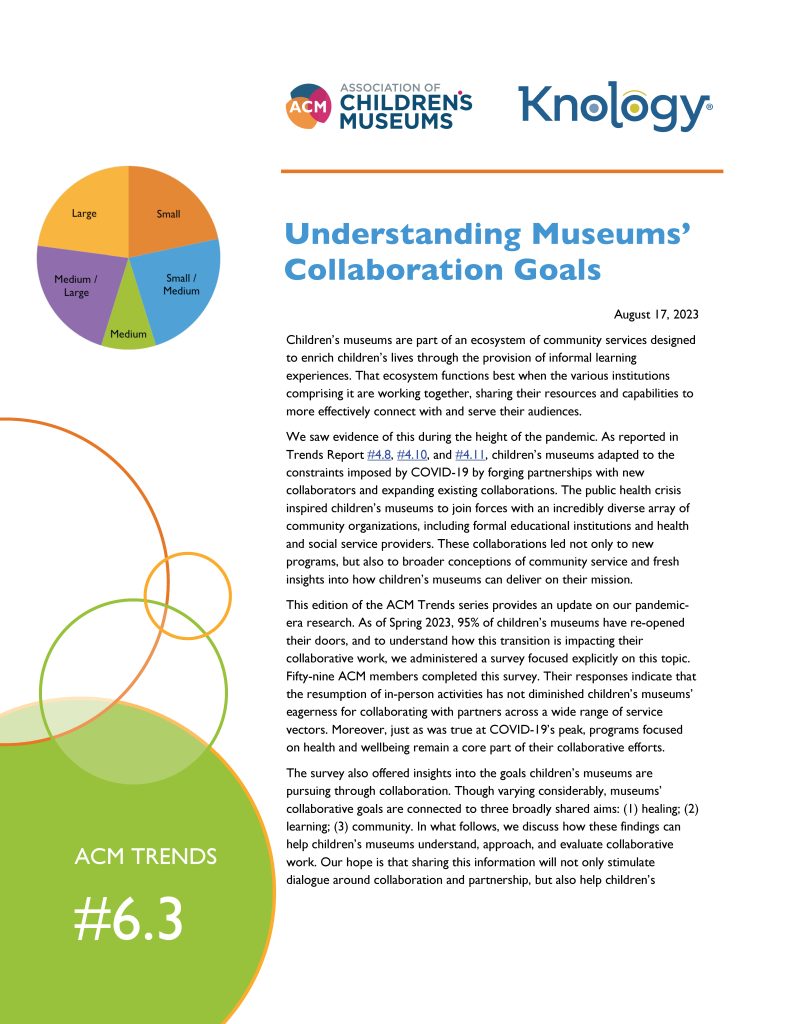
Data for this report was collected through a Spring 2023 ACM member survey on collaborations. The dataset contains information from 59 member institutions. Previous pandemic-era survey data on collaborations conducted during the height of the COVID-19 pandemic supported instrument sevelopment. This research was supported by the Institute for Museum and Library Services
Children’s museums are part of an ecosystem of community services designed to enrich children’s lives through the provision of informal learning experiences. That ecosystem functions best when the various institutions comprising it are working together, sharing their resources and capabilities to more effectively connect with and serve their audiences.
We saw evidence of this during the height of the pandemic. As reported in Trends Report #4.8, #4.10, and #4.11, children’s museums adapted to the constraints imposed by COVID-19 by forging partnerships with new collaborators and expanding existing collaborations. The public health crisis inspired children’s museums to join forces with an incredibly diverse array of community organizations, including formal educational institutions and health and social service providers. These collaborations led not only to new
programs, but also to broader conceptions of community service and fresh insights into how children’s museums can deliver on their mission.
This edition of the ACM Trends series provides an update on our pandemic-era research. As of Spring 2023, 95% of children’s museums have re-opened their doors, and to understand how this transition is impacting their collaborative work, we administered a survey focused explicitly on this topic. Fifty-nine ACM members completed this survey. Their responses indicate that the resumption of in-person activities has not diminished children’s museums’ eagerness for collaborating with partners across a wide range of service vectors. Moreover, just as was true at COVID-19’s peak, programs focused on health and wellbeing remain a core part of their collaborative efforts.
The survey also offered insights into the goals children’s museums are pursuing through collaboration. Though varying considerably, museums’ collaborative goals are connected to three broadly shared aims: (1) healing; (2) learning; (3) community. In what follows, we discuss how these findings can help children’s museums understand, approach, and evaluate collaborative work. Our hope is that sharing this information will not only stimulate dialogue around collaboration and partnership, but also help children’s museum leaders plan new collaborative programs and begin the process of building relationships with new partners.
With the waning weeks of the summer of 2023, children continue to make the most of every moment at Please Touch Museum (PTM) in Philadelphia. This is especially true for rising kindergarteners, who are getting ready to pack their backpacks, find their cubbies, and meet new friends. And the 80 children and their caregivers who participated in PTM’s Kindergarten Readiness Experience this summer are well-prepared for new adventures in learning. The program was recently featured in The Inquirer, highlighting the importance of social and emotional skills in preparation for kindergarten.
PTM’s Kindergarten Readiness Experience is advancing how children prepare to transition to kindergarten, ensuring they enter the classroom on their first day full of creativity, compassion, confidence, and curiosity. Entering kindergarten is a milestone for young children and families. PTM remains committed to supporting the journey from home to school by building the critical social-emotional skills needed for a successful transition.
The Kindergarten Readiness Experience was also highlighted in the American Alliance of Museums’ recent reaccreditation report, which specifically cited the program as worthy of study by other museums. Together, these remarkable endorsements help celebrate yet another way in which PTM changes a child’s life as they discover the power of learning through play.
“There’s a lot of research to suggest that if a child is ready for kindergarten, they’re going to do better in the future academically and socially [and] emotionally.
– Alyssa Liles-Amponsah, the senior director of community programs and inclusion at the Please Touch Museum via The Inquirer
It’s so important to intervene as early as possible with children and make sure they have all the skills they need to be successful in kindergarten so it sets their trajectory on a positive pathway.”
Play is a powerful experience that enriches people’s lives in museums, schools, homes, and beyond. In this latest ACM Informational Brief, The power of play in children’s museums and elsewhere, play is explained through the research-based benefits of play to children’s discovery, health and wellness, and agency, as well as through the crucial role children’s museums play in cultivating and providing access to play.
Although the benefits of play can occur in many different types of environments, children’s museums offer particularly valuable contexts for play.
Play is vital for children, young people, and adults as well. Children’s museums have vast experience in creating playful learning experiences that are age-appropriate, hands on, interactive, and joyful. Even beyond their walls, museums form partnerships and build capacity to encourage more playful learning experiences in schools, homes, parks, hospitals, airports, malls, and beyond. Children’s museums provide examples of the many ways parents, caregivers, and educators can use play to facilitate wellbeing, healthy brain development, and to make learning more effective and joyful for everyone. As children’s museums, we believe in the power of play and we strive to nurture more play and playful learning everywhere we go.
Paper commissioned by ACM | Written by KT Todd, Director of Learning and Research, Children’s Museum of Pittsburgh
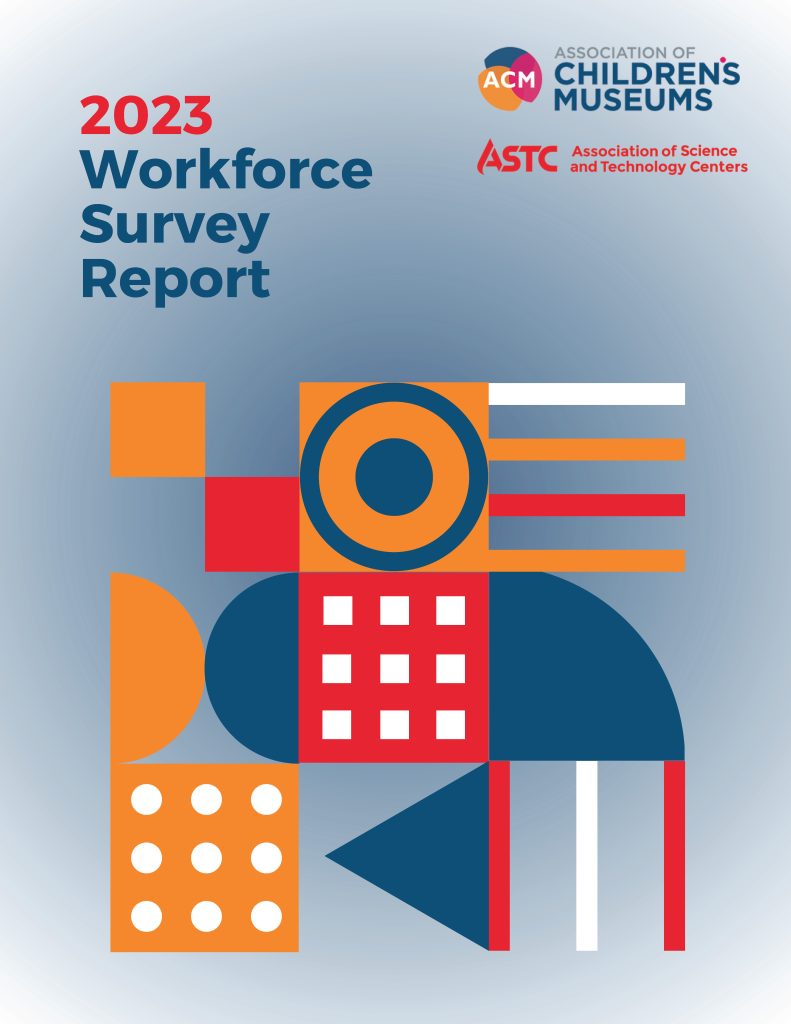
For more information, the 2023 ACM-ASTC Workforce Survey Report can be retrieved via ACM or ASTC. A digital download of the report is available for purchase ($199 ACM or ASTC member/$499 non-member).
ACM members and nonmembers may download the association’s publications order form and send it to membership@acm.org.
ASTC members may purchase their report via myASTC.astc.org.
The Association of Children’s Museums (ACM) and the Association of Science and Technology Centers (ASTC) are pleased to announce the release of the 2023 ACM-ASTC Workforce Survey Report. This report presents findings from 138 participating institutions, 36% of which are active ACM member museums, and 81% of which are active ASTC member museums. ACM and ASTC worked together on previous efforts to capture this data and share with the community, most recently in 2016.
The purpose of this joint data collection effort is to provide museum professionals and leadership with an understanding of important staffing trends in the museum world, as well as analysis that can help institutions understand how their own policies relate to institutions of similar size or type.
Key Findings
• Full-time staff numbers are rebounding to their pre-pandemic levels, but part-time positions remain down by almost 15%, and volunteer numbers are lower as well.
• 65% of institutions report that they are currently hiring floor/frontline staff, far above the percentage that reported currently hiring for any other positions.
• Full-time staff salaries are up by 15% since 2019 and approximately 6% in the past year.
• Part-time hourly wages increased 23% since 2019 and approximately 7% in the past year.
• Benefits that institutions offer staff have not changed dramatically since the 2016 workforce survey. Currently, more than 80% of institutions report contributing to employee health insurance.
• Questions on remote work arrangements show that the majority of museum work is still being done primarily in-person. At the same time, many respondents said the demand for remote work flexibility is a major challenge in recruiting new staff.
• 11% of institutions reported have some unionized staff, but unionization is typically limited to only certain roles or departments.
• Demographic information on staff is quite limited, raising questions for how institutions can measure their progress toward diversifying the field.
The 2023 ACM-ASTC Workforce Survey Report paints a picture of a field that is moving forward from the pandemic, but not without challenges. Compensation is rising and staff numbers are rebounding, but these trends are not consistent across all types of staff. Museums are looking for ways to attract and retain staff in a time when many workers are navigating career transitions, but they are also encountering obstacles as workers sometimes find more competitive pay, benefits, or work policies in other fields.
The full 2023 ACM-ASTC Workforce Survey Report provides a closer look at these numbers and issues, with breakouts by institution type, size, and location to help organizations understand where their own policies and practices lie in comparison to the larger field. A robust executive summary is available open access for free.
Monday, July 17, 2023, 3:00 PM ET
Please join ACM and ASTC for a free webinar—open to all—to learn more about the survey instrument and our findings. Attendees will hear from ACM’s Jennifer Rehkamp, Director of Field Services and Research, and ASTC’s Melissa Ballard, Director of Programs.
With approximately 40 emerging museum ACM Members, we are thrilled to see more intentional and meaningful spaces for children’s museums coming together across the globe!
This week, ACM Executive Director Arthur Affleck represents the association at the Grand Opening of Young V&A in Bethnal Green, London. After seven intensive years of dedicated planning and design, the free, national museum will showcase the power of creativity in children’s lives as they build new skills and develop the creative confidence needed to thrive in our fast-changing world.
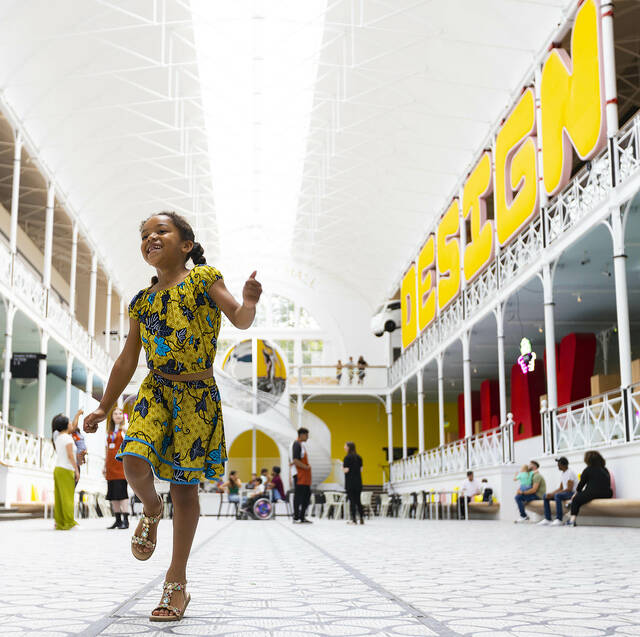
Co-designed with children, Young V&A demonstrates what it means to be a children’s museum by serving as a local destination that encourages positive child development and adult/child interactions through naturalistic and child-centered learning.
Emerging museums are an important part of the children’s museum community. Representing those institutions that are not-yet-opened, emerging museums bring new vision, new perspectives, ideas, and talents.
In recent years, many of our emerging museums represent the international growth of children’s museums. We are pleased to have welcomed attendees from across the globe at our recent InterActivity 2023: Leveraging Our Voice conference in New Orleans. This included attendees from Canada, Mexico, South Korea, Israel, Germany, Curaçao, China, and Poland, as well as the U.K.
“Children’s museums are the fastest growing sector of the museum community because there is an increased recognition of the power of the hands-on, interactive, and playful learning exhibits and experiences they provide…
– ACM Executive Director, Arthur G. Affleck, III via The Financial Times
We have found children’s museums and targeted programming serving as extension of the home and school environments. This ‘third space’ allows for stronger communities, safe spaces for growth and discovery, and a world of opportunity.”
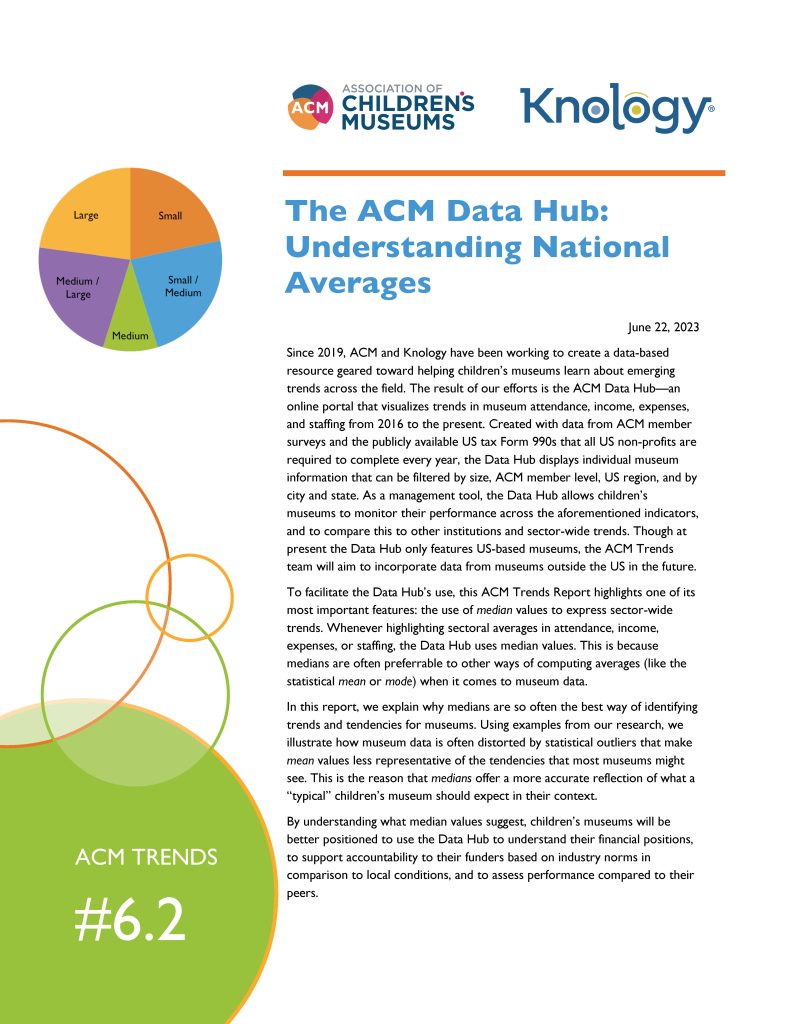
Data for this report was drawn from publicly available IRS Form 990s posted on Candid and the ProPublica nonprofit look-up tools. Supplemental data was collected through the Spring 2022 ACM member survey.
Since 2019, ACM and Knology have been working to create a data-based resource geared toward helping children’s museums learn about emerging trends across the field. The result of our efforts is the ACM Trends Data Hub—an online portal that visualizes trends in museum attendance, income, expenses, and staffing from 2016 to the present. Created with data from ACM member surveys and the publicly available US tax Form 990s that all US non-profits are required to complete every year, the Data Hub displays individual museum information that can be filtered by size, ACM member level, US region, and by city and state. As a management tool, the Data Hub allows children’s museums to monitor their performance across the aforementioned indicators, and to compare this to other institutions and sector-wide trends. Though at present the Data Hub only features US-based museums, the ACM Trends team will aim to incorporate data from museums outside the US in the future.
To facilitate the Data Hub’s use, this ACM Trends Report highlights one of its most important features: the use of median values to express sector-wide trends. Whenever highlighting sectoral averages in attendance, income, expenses, or staffing, the Data Hub uses median values. This is because medians are often preferrable to other ways of computing averages (like the statistical mean or mode) when it comes to museum data.
In this report, we explain why medians are so often the best way of identifying trends and tendencies for museums. Using examples from our research, we illustrate how museum data is often distorted by statistical outliers that make mean values less representative of the tendencies that most museums might see. This is the reason that medians offer a more accurate reflection of what a “typical” children’s museum should expect in their context.
By understanding what median values suggest, children’s museums will be better positioned to use the Data Hub to understand their financial positions, to support accountability to their funders based on industry norms in comparison to local conditions, and to assess performance compared to their peers.
Mental health is important.
Children’s museums have long been invested in creating environments where children thrive. Mental health is a pressing current issue for the children in our communities, and children’s museums have expansive opportunity to meet those needs with comprehensive, collaborative experiences that supplement the essential work of mental health professionals—providing all children with the skills to navigate their world with joy, wonder, and wellness.
ACM’s latest information brief “The role of children’s museums in supporting children’s mental health“, provides an overview of some primary research trends about children’s mental health and then shares insights about how children’s museums—community-serving organizations that reach millions of U.S. children each year—can bolster children’s mental health.
Paper commissioned by ACM | Written by KT Todd, Director of Learning and Research, Children’s Museum of Pittsburgh
Children’s museums are constantly responding to the current needs of the children and families in their communities, from health to academics to social issues, as seen in their exhibits, outreach, and programming. Children’s museums also fulfill their roles as responsive, audience-focused institutions by striving to reflect and address community needs through the experiences they create.
While ACM and the children’s museum community cannot eliminate all the threats to children’s health, safety and well-being, the organization is committed to using its playful learning approach, and its advocacy, programming, and community partnerships to address these problems proactively and with a sense of urgency.
Recently ACM’s Executive Director, Arthur G. Affleck III participated in a special roundtable discussion hosted by the National Children’s Museum in Washington, D.C. Joined by Ginger Zee, Chief Meteorologist and Managing Editor Climate Unit at ABC News, and Kim Noble, Senior Advisor for Environmental Education at the US Environmental Protection Agency, Arthur explore the topic of Climate Action Heroes: Empowering Future Climate Innovators. The full roundtable discussion can be viewed here.
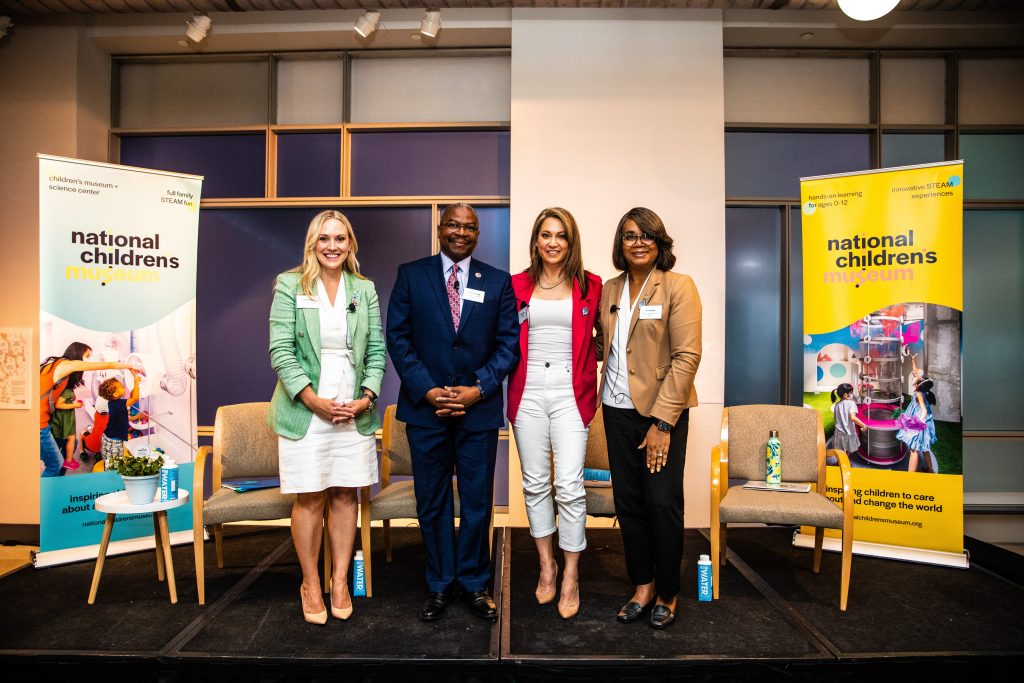
Moderated by Crystal Bowyer, President & CEO of National Children’s Museum, central themes from the panel focused on climate and humanity, easing climate anxiety, partnerships, and the power of play.
Children, as the most vulnerable group affected by climate change, also hold the greatest potential as agents of change and resilience. To nurture the next generation of climate innovators, it is crucial to instill a love for nature and science through play-based, interactive learning, emphasizing hope rather than fear. It is the shared duty of public and private sectors to forge partnerships that promote awareness and inspire action in this endeavor.
“This isn’t about science, it is not about statistics, it is not about how high the water level was… it’s about the humanity of the people … that’s what we can give children. Not just the education and the information but where and how do I take action with whatever I have in front of us?”
Ginger Zee
“We can talk to children in a way that doesn’t come from a place of fear but a place of possibility. We can confront climate change and talk to our kids in a way that teaches them about creativity, innovation, resilience. We can teach them what it means to imagine a world with a planet with clean air, clean water, for everyone. That learning can come from a place of growth.”
Kim Noble
“The reason why play is so important is that you want the lesson to stick, you want children to want to know more about it. If you make it fun, if you make it interesting, if you make it interactive, and iterative, and joyful: they are likely to get the lesson. We use play-based approaches to teach about climate and so many other concepts.”
Arthur Affleck
Climate Action Heroes is part of the National Children’s Museum innovative educational programming. More information may be found at the NCM website.

This post originally was published by Knology. Access the article here: Museum Virtual Programming after COVID-19 – Knology
Children’s museums responded to the COVID-19 shutdowns of 2020 and 2021 by developing new forms of programming, delivered through virtual platforms. At the pandemic’s outset, the Association of Children’s Museums (ACM) launched “Children’s Museums at Home,” a website providing families with links to virtual programs created by ACM member museums. Following up on this, individual children’s museums developed a number of other virtual strategies. They live-streamed, produced podcasts and YouTube videos, developed online games and contests, and distributed digital newsletters.
Initially, these different forms of virtual programming were envisioned as temporary adjustments—as necessary adaptations to a short-term crisis. Yet moving online taught children’s museums that the use of digital technologies and virtual spaces could have long-term benefits. In particular, they offered a way to reach new audiences—including those historically lacking access to children’s museums. With the resumption of in-person activities, many are asking what aspects of these virtual services should be retained. How much virtual programming do audiences want? How much potential is there for reaching new audiences with this programming? How might this be managed given children’s museums’ limited budgets? And how would these efforts relate to in-person programming?
In 2021, as more and more children’s museums migrated to online spaces, Knology and ACM began gathering data on all aspects of digital content creation. In addition to this, we held a workshop for children’s museum leadership to discuss the strengths, weaknesses, opportunities, and threats of continued virtual programming in a post-COVID world. Concurrently, Rockman et. al. conducted survey research to learn about parents’ and caregivers’ experiences with and preferences for different types of virtual programming, and to determine how much demand for this there would be after children’s museums resumed in-person operations.
In 2022, the ACM Trends Reports team documented both the benefits and challenges associated with continued virtual programming efforts. These reports indicate that both children’s museum leaders and patrons want virtual programming to outlive the COVID-19 pandemic. The challenge for leaders is now to make future investments that support community needs, and reach new audiences without adversely impacting children’s museums’ capacities.
To support the field, ACM, Knology’s Trends team, and Rockman et. al. received funding from the Institute for Museum and Library Services (IMLS) to pursue “Post-Pandemic Virtual Experiences with Children’s Museums: Responding to Family, Educator, and Museum’s Needs and Expectations.” We’re calling it the Museum’s Virtual Programming project, for short (MVP).
MVP aims to provide children’s museums with actionable data that can help them decide whether and how virtual programming might best meet the needs of the communities they serve. The project will also explore how ACM can create opportunities for asset sharing and development tools to optimize virtual programming for children’s museums of all sizes—along with their community partners.
This three-year project will assess the virtual programming assets and needs of the children’s museum community by working, first and foremost, with the ACM membership, and by speaking with families, parents, caregivers, and local educators across the country to help build recommendations that can align with the scale and operations of children’s museums of all sizes. In Fall 2022, our team will be developing baseline instruments and criteria for a cohort of ten ACM member museums who will work with their audiences and community partners to facilitate data collection. This data collection will begin in Spring 2023, and will be led by Rockman et al. Concurrent with this, ACM and Knology will begin diving deeper into ACM member museum’s virtual programming offerings.
As with all ACM, Knology, and Rockman et al initiatives, the team will center its work in principles of equity. Although the shift to online programming has not been as easy for those living in marginalized communities, that does not discount the value of online for all. Together, the team will consult with children’s museum member families, early childhood educators, and those who lack access to children’s museums or live in traditionally underserved communities.
Together, we believe that a collaborative approach can create a path to better meet the needs of those audiences who have historically not been able to access children’s museums, and to help all institutions within this field extend their reach and services.
To review the fifth volume of ACM Trends Reports, please click here.

| This post was originally published as ACM Trends Report 6.1, the first report in the sixth volume of ACM Trends Reports, produced in partnership between ACM and Knology. |
Members are the lifeblood of many children’s museums. They are loyal patrons who trust museums to provide playful learning opportunities for their children, often complementing trips to the zoo or aquarium. But when children “age out,” families may turn to other cultural institutions and start to reconsider the value of their membership. Understanding value seekers’ calculations can help children’s museums cultivate trust through transparency.
In this Trends report, we look at what membership pricing and attendance data can tell us about children’s museums. We focus on what museums might want to think about when attempting to stabilize their membership base, and on how to forge trusting relationships with prospective members.
National data related to membership pricing has been of particular interest to the ACM leadership community in recent years, especially as it relates to post-pandemic operations. Prompted by a specific request from an ACM member, this report contributes to these ongoing discussions. We used data from the Spring 2022 targeted ACM member survey and collected additional information from member museum websites. We developed a dataset from 90 children’s museums to see if there were differences in membership costs between small, medium, and large museums. We also compared admission prices across these categories and calculated a “pay less” point—that is, the number of times a family of four would need to visit in order to make the
purchase of an annual membership a cost-saving act.
Our analysis yielded two main findings. First, even though admission prices and membership costs are highest for large museums, the number of single visits needed by a family of four to “pay less” is lower for these museums than it is for their small and medium-sized counterparts. Second, we confirmed that admission prices and membership costs tend to rise in parallel, which means that even though base admission prices may be determined based on local cost of living concerns, ACM members can still compare their rates to other children’s museums, Taken together, these findings can help children’s museums determine how to align pricing decisions with the needs and interests of value-seeking visitors—that is, those who purchase memberships based on a calculation of savings.
In Spring 2022, the ACM Trends Team circulated a survey to ACM member institutions requesting data on attendance, admission prices, membership costs, and other operations. After supplementing this data with information gleaned from member websites in August 2022, we assembled a dataset of 90 museums (30 of each size). We summarize the data in Table 1 below.
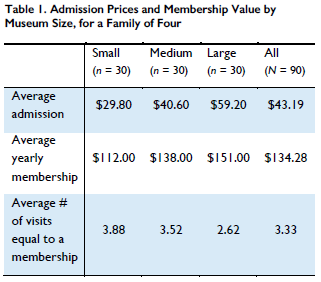
Table 1 compares admission and membership prices for a family of four at small, medium, and large museums. Admission prices are based on the general admission price for adults and children. When prices for adults and children were different, a family of four was calculated with two adults and two children.
We calculated these figures for a two-adult, two-child family on account of current US Census data (which shows that the average US family contains 3.13 people), and because this aligns with demographic research showing that a plurality of mothers in the US today report having two children (Pew Research Center, 2015).
The bottom row in Table 1 presents the average number of times a family of four would need to pay admission before achieving cost-savings through a membership purchase. The fourth column illustrates the mean cost across all size categories—which is an appropriate way to calculate averages in a dataset like this one, as it contains few outliers.
Clearly, the larger the museum, the higher the membership and admission costs for a family of four. Nevertheless, the number of visits needed for a valueseeker to “pay less” for multiple visits through a membership is lower (2.62) for large museums than for their small (3.88) and medium-sized (3.52) counterparts.
Figure 1 presents data from the bottom row of Table 1 as a “box and whiskers” plot. To create this, we “normalized” pricing data to show membership costs (for a family of four) as a multiple of admission costs for each children’s museum. The “box” part of the plot illustrates the middle half of the data (in other words, where 15 of the 30 museums in each size category sit), while the “whiskers” indicate those museums where prices are higher or lower than their peers.
When a museum stands alone compared to others, the box and whiskers plot expresses this with dots, considered outliers. When multiple museums lie in the same range, this is indicated by a line placed above the box. The line in the middle of the box illustrates the median, or the exact middle of all of the data in that category. We can see from those lines that medium-sized and small museums tend to be near one another. To see how many visits a family of four would need to make before generating savings through the purchase of a membership, look at the Y-axis, which plots the ratio of membership costs to visit price. This data can be used as a foundation for making decisions about membership pricing, especially in connection with data on premiums.
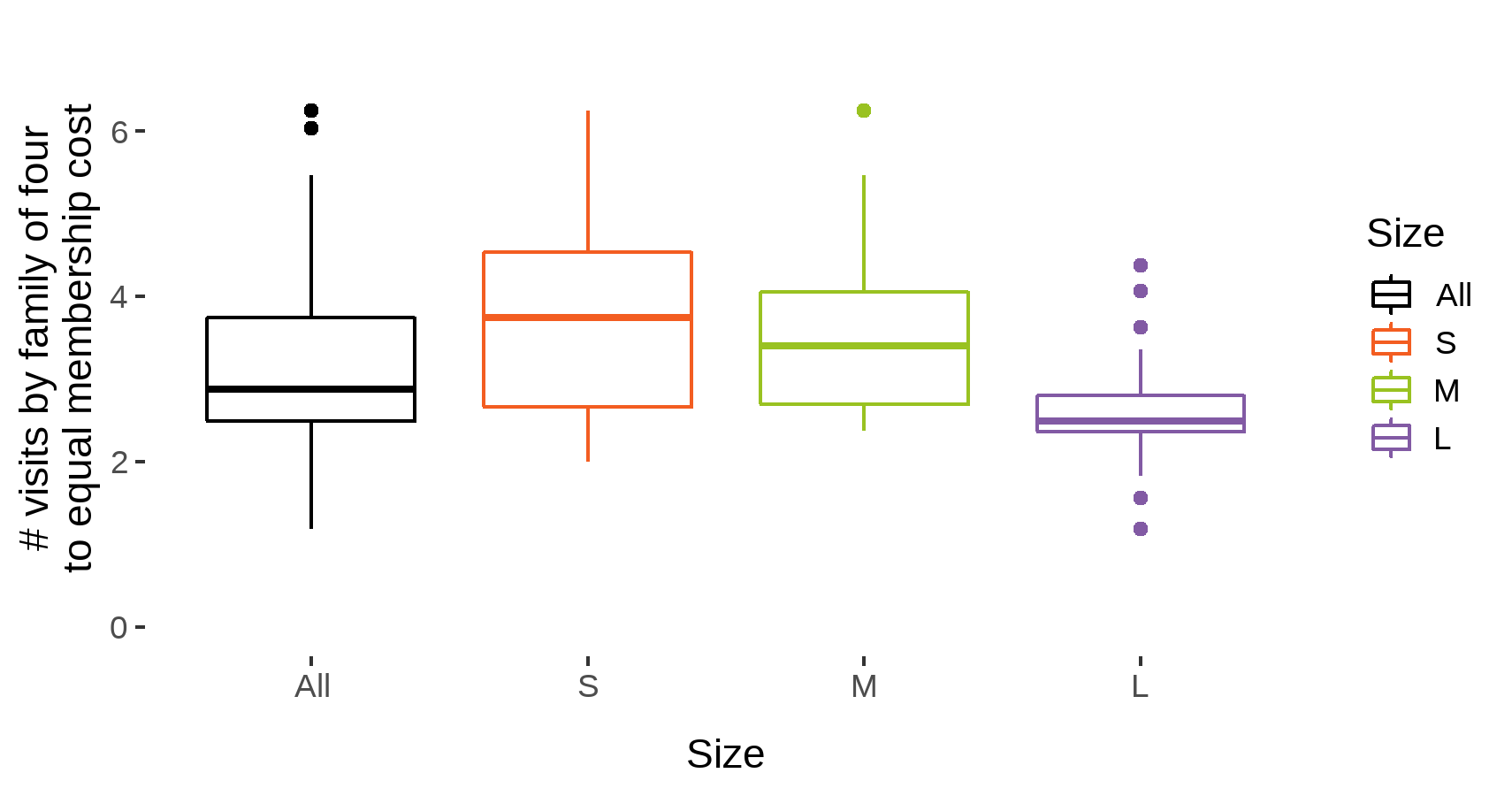
We also collected data on additional benefits provided with museum memberships—for example, discounts for rentals or birthday parties (n = 60), member-only events (n = 53), and reciprocal admission to other ACM (n = 24) or ASTC (n = 13) member institutions. Most museums offer these in some form; 8 out of 10 small museums, 9 out of 10 medium-sized museums, and all large museums indicated additional membership benefits. The total number of additional benefits did not appear to be related to a higher value of memberships.
One benefit, however, did have a significant effect on “trips to match cost.” Offering a discount on space rentals, after accounting for museum size, was related to higher membership costs. Though some have suggested that early access or discounts on summer camps are perceived as an incentive for families who can afford summer camp experiences, our analysis did not provide any evidence that the benefit is related to higher or lower membership prices.
We also looked at a subset of the data from fifty-one museums (1 small, 15 medium-sized, 20 large, and 3 yet to be classified) who responded to the Spring 2022 ACM member survey and provided information on annual attendance and member attendance from FY2016 to FY2021. Looking at the data, we can determine historical trends in museum attendance, and also calculate the proportion of overall attendance consisting of museum members.
Prior to the pandemic, in FY2016 through FY2019, the median number of memberships purchased per year for these museums was between 2200 and 3000. In FY2020 and FY2021, this value dropped to 968 & 1188 memberships purchased, respectively. Along with this decline, the proportion of overall visitors who were
museum members decreased roughly 6% in 2021 for these museums. While these museums are just a portion of the overall ACM field, the decline likely reflects the impact of the pandemic across the sector.
People purchase museum memberships for different reasons. These purchases provide a reason for frequent visits—which not only benefits children but can also help museum leaders advocate for children’s access to the healthy spaces of learning and discovery children’s museums provide. For some, a membership is a valueseeking purchase, one made through a consideration of future costs, benefits, and savings. Value-seekers become members because they want museum-going to be a regular part of their children’s lives. These pricing data tell us that museums anticipate four visits a year by their value-seeking members, setting prices that justify at least four or more visits in a membership year.
For others, purchasing a membership may not be driven by monetary concerns. They may simply want to invest in an institution that is doing good work, or to support a local institution that is good for children. Some individuals may purchase memberships to build social capital, because they want to support an organization whose values they identify with, and because they want their membership to reflect something about who they are. They may also become members because they want to encourage their grandchildren, nephews, nieces, or other relatives to visit them, or because they want to provide gifts to families with children. These “affinity members” may also care less about free admission than about membership perks, premiums, or about symbolic value—for example, discounts on birthdays or group tours, reciprocal admission at other ACM member museums or other cultural institutions, access to priority registration, exclusive programs, or behind-the-scenes content.
In other words, value is a complex, multidimensional thing. When thinking about those who see the primary value of a museum as its price, children’s museum leaders can also consider how decisions related to pricing might impact the perceived trustworthiness of their institutions. As ACM Trends #5.3 discussed, in order to cultivate public trust, museums need to demonstrate competence, reliability, sincerity, integrity, and benevolence. During the height of the pandemic, many museums demonstrated benevolence through refunds or by pro-rating existing memberships. At present, some museums are considering increased fees to recoup pandemic-related monetary losses. Doing so may risk the trust built through the pandemic, especially as cost-of-living increases may make more members value-seekers.
Data for this report was collected through: (1) an online survey distributed by ACM in April 2022; (2) a review of ACM member institutions’ websites. This dataset contains information from 90 current ACM member museums.
Our analysis used the size categories developed in ACM Trends Reports #1.1 and #1.7. We use these categories because institutional size predicts a range of outcomes for children’s museums. We note that museums offer many types of reduced priced tickets or free admission, and some unique premiums that were not used in this analysis.
Voiklis, J. (2022). Key Concepts: Trust. ACM Trends 5(3). Livingston, G. (2015). “Childlessness Falls, Family Size Grows Among Highly Education Women.” Pew Research Center.
US Census Bureau (2021). America’s Families and Living Arrangements. Retrieved from: [https://www.statista.com/statistics/183657/average-sizeof-
a-family-in-the-us/]
This project was made possible in part by the Institute of Museum and Library Services. The views, findings, conclusions or recommendations expressed in this publication do not necessarily represent those of the Institute of Museum and Library Services.
The Associations of Children’s Museums (ACM) champions children’s museums worldwide. Follow ACM on Twitter, Facebook, and Instagram. Knology produces practical social science for a better world. Follow Knology on Twitter.